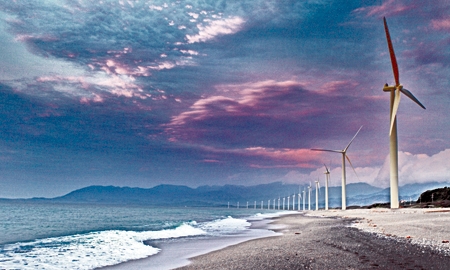Increased ‘green’ power generation from geothermal, wind and hydro sources can reduce dependency on costly imported fossil fuels – thereby making the benefits financial as well as environmental.
Currently, the Philippines relies heavily on foreign energy sources: imported coal and crude oil accounted for 50 per cent of the total energy supply in 2007. Yet the country has rich renewable energy potential, including robust wind energy sites, ideal solar conditions, and many geothermal and biomass resources. In fact, it is already second only to the U.S. in terms of geothermal energy production.
The country wants to further reduce air pollution, with Ramon Paje, Secretary of Department of Environment and Natural Resources (DENR) aiming to popularize the use of electric tricycles. “The ultimate aim is for our country's five million tricycles, of which 2.8 million are in Metro Manila, to become zero-emission vehicles,” he said.
Another plan is to convert current diesel-run ‘jeepneys’ –a major public vehicle in the Philippines – into electric vehicles.
This, Paje said, would keep the cultural identity of the jeepney as uniquely Filipino, while at the same time increasing reducing emissions.
Prompted into action by the 2008 fuel crisis, the Department of Energy created the Renewable Energy Act. Its aim is to promote the development and commercialisation of renewable energy resources to achieve national energy security, reduce greenhouse emissions, be of better value to the consumer, and reduce energy imports. Fiscal and non-fiscal incentives to private sector investors, equipment manufacturers and suppliers are being offered to help reach these targets.
The National Renewable Energy Program, launched in June this year, aims to triple renewable energy capacity to 15,400 megawatts by 2030.
"Renewable energy resources are expensive because it’s emerging technology, but in the long term the price come down, making it cheaper than traditional sources," Layug said.
The Philippines is set to host a bio-energy conference dubbed “Be Independent, Go Green Energy,” on January 12-13 next year, to help develop a robust and profitable sector in the country.
It hopes to encourage more investors to become involved in biofuel feedstock production and processing, and renewable energy production including biomass feedstock production and biopower generation.
President Aquino is expected to grace the event, along with Mr. Paje and Energy Secretary Jose Rene Almendras.

0 COMMENTS